THE DEVELOPMENT OF STAINED GLASS IN ENGLAND
A Brief History of Stylistic Development in English Stained Glass
Origins
Although glass is an ancient material, the Romans appear to have been the first to use glass in windows. In the UK, fragments of coloured window glass dating to the 7th century have been excavated at sites of monasteries in Monkwearmouth and Jarrow in Northumbria. The Anglo-Saxons may have been making stained glass windows, using coloured glass and lead, but essentially, stained glass as we know it was a medieval art form which was widely used in gothic architecture.
12th Century
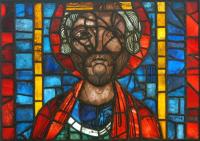
Bust of a King, c.1210
The earliest windows at Canterbury Cathedral contained two figures, one above the other, depicting the genealogy of Christ. The figures were in the clerestory and are large so that they can be clearly seen from the ground. Those few that remain have dramatic grandeur and the painting has great simplicity and strength, accentuated by the lead lines. There is a great range of deep colours. The Stained Glass Museum holds a similar example from Soissons Cathedral, France, dated c.1210.
13th Century
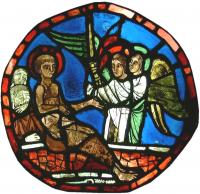
St Vincent Roundel, c.1225-50

Geometric grisaille panel, c.1200-50
In addition to 'figure' windows, the thirteenth century saw the increasing popularity of 'medallion' windows. These were often intended for the aisles of a church. Early in the 13th Century the Trinity Chapel was built at Canterbury as a shrine for St Thomas Becket, and the medallions and panels in the windows are devoted to the depiction of his life and the miracles performed after his death. The stories are illustrated with brilliant colours and with great dramatic intensity and economy. The borders around them are broad with deep colours and elaborate patterns. The roundel of St Vincent, pictured here, is a similar example of a panel from a medallion window from France.
During the 13th Century the use of decorative 'grisaille’, or clear glass was developed. Grisaille glass had the advantages of being cheap and letting in more light. The most famous example in England is the Five Sisters window at York Minster. This window is predominantly made of white (or clear) glass, painted with an ornamental network of foliage and patterns with an occasional inset of coloured glass. This example of an early 13th century grisaille panel in the museum not only still has most of its original glass but also most of its original leads.
14th Century

Annunciation to the Virgin, c.1340
Glaziers responded to changes in architectural styles, and had to adjust their designs from the single lancet Norman windows of the 13th Century to the much larger and more complicated windows of the 'Decorated' period. These later gothic windows were often divided into several lights by vertical stone mullions. The narrow elongated openings created by the stonework presented challenges for stained glass artists, who responded by creating 'band' windows with pictorial or figurative panels across the windows alternated with bands of grisaille, as in the windows of Merton College, Oxford (1298-1311).
As the century progressed, ever more lofty and elaborate architectural canopies were introduced above the figures to occupy the space available, as in the West window in York Minster given in 1338.
The figures lost their former dramatic power and the panels their narrative interest, but the features were more carefully drawn and the robes were looser and more flowing. Many of the figures stand in an exaggerated 'S' pose which is typical of the period. In this period silver stain (or yellow stain) was also introduced. The application of silver stain, a silver nitrate compound, to white (or clear) glass 'stained' those parts yellow when fired in the kiln. This enabled glaziers to have more than one colour on a single piece of glass, and revolutionised glass painting. Many of these features can be seen in the window depicting the Annunciation to the Virgin in the Museum which came from Hadzor Church, Worcestershire.
15th Century

St Bartholomew
In the 15th Century narrative and subject matter become more varied and complex, as can be seen if one compares the West window in York Minister mentioned above with the great East window there, painted between 1405 and 1408. This window, designed by John Thornton of Coventry, depicts the beginning and end of all things from the book of Genesis to the book of Revelation, known in the Middle Ages as the Apocalypse. The window contains row upon row of little panels crowded with figures, delightfully and delicately drawn. Similar scenes can be found in the glass of the small parish churches of York.
Great Malvern Priory Church, in Worcestershire, contains a large amount of original glass and still today gives an impression of what a large church looked like in the 15th Century (c.1440-1506).
In this period, heads were increasingly painted on white glass, and carefully modelled (shaded with a variety of brushes). As artists study of the human figure improved, hands and feet resemble natural shapes and proportion. Borders become narrower, colours are pale and more varied, and there is less interest in pattern.
The figure of St Bartholomew, loaned to the Museum from the Victoria & Albert Museum, shows many features of these changes in styles, although it has been heavily restored.
16th Century
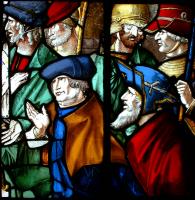
Scene from the legend of St James 1500-50
As visible in the great East window in King’s College Chapel, Cambridge, commissioned in 1526, there was a slow but continuous movement towards three-dimensional modelled figures in the sixteenth century. In such large windows the mullions were often ignored and the window is treated as one unbroken pictorial space.
Increasingly, designers began to imitate easel painting with the use of enamel pigments and ignored the traditional techniques of stained glass, in which lead lines formed part of a mosaic glass design. The political and religious effects of the Reformation halted any further developments in England, and in the next two centuries more stained glass was destroyed than commissioned.
Stained glass had no place in the architectural styles of Baroque and Rococo, which favoured plain glazed windows and bright light to show off the magnificence of its interior. When stained glass was used in these buildings, it was frequently deprived of religious subject by political edict.
17th Century and 18th Century
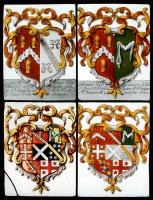
Shield of Arms c.1691-95
Glaziers’ energies turned to the art of heraldry, which was particularly suited to the use of coloured enamel paints, and an enormous amount was produced in the 17th and 18th Centuries. Heraldic painted glass was often of great elaboration and delicacy; there is an example in the Museum from Denham Place, Bucks, painted by William Price the Elder.
There was a brief revival of religious painting in the reign of Charles I under the encouragement of Archbishop Laud, around 1630. In several Oxford Colleges there is fine work by Abraham and Bernard Van Linge, members of an Emden glass-painting family.
It was not until the 18th Century that pictorial windows were produced again in any number. These glaziers emulated easel paintings, using enamel pigments and often painting from cartoons supplied by painters in oils. Various members of the Price family produced interesting examples, particularly for Oxford Colleges. One example on display in the museum, is a portrait of George III, painted by James Pearson and on loan from the Royal Collection. The window is a copy of an oil-on-canvas painting by Joshua Reynolds, skilfully painted onto clear glass using coloured enamels and silver stain. These windows were in effect transparent oil paintings and lacked the radiance and architectural relevance of medieval windows.
19th Century
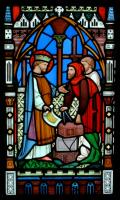
Solomon Supervises the Building of the Temple, by Clayton & Bell, c.1860
Some stained glass from this period was ‘overly manufactured’ and of poor design quality, however many firms reached and maintained a high standard of workmanship, and there are fine examples in the Museum (and in Ely Cathedral) from Clayton & Bell, Heaton, Butler & Bayne, and Lavers & Barraud.
The glass from Morris & Co (formed in 1861) dominated the last quarter of the nineteenth century, and the designs of Burne-Jones and other Pre-Raphaelites rose above the pious sentimentality of much Victorian work, and lead lines became once again a vital part of the design.
20th Century
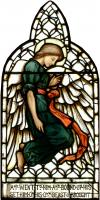
Kneeling Angel, 1893
Both the Arts and Crafts and Art Nouveau movements included stained glass amongst other furnishings and interior design. The Scottish architect, Charles Rennie Mackintosh, in the early years of the 20th Century designed everything in the Glasgow Art School and the Willow Tea Rooms, including remarkable stained glass doors. The Museum has a religious window, showing a kneeling angel from a member of this famous Glasgow School, Harrington Mann.
Stained glass is an art dependent on architecture, and the straight lines and innovations of Modern Architecture, based on concrete and steel, provided stained glass artists with new opportunities, particularly after the destruction caused by World War II, when much rebuilding was necessary.
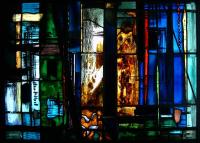
Experimental panel, c.1956
In France, famous artists like Matisse, Braque and Leger created modern church windows which broke with traditional religious art. In Germany, architects have made use of walls of stained glass in churches, and also in secular buildings. A talented generation of stained glass artists, like Buschulte, Schaffrath and Schreiter, grasped the opportunities presented to them.
Present Day
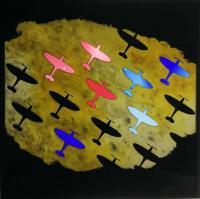
Spitfires, by Brian Clarke, 2017 (2019.1)
© The Stained Glass Museum
Citation: 'A Brief History of Stylistic Development in English Stained Glass', The Stained Glass Museum [webpage, date accessed].
